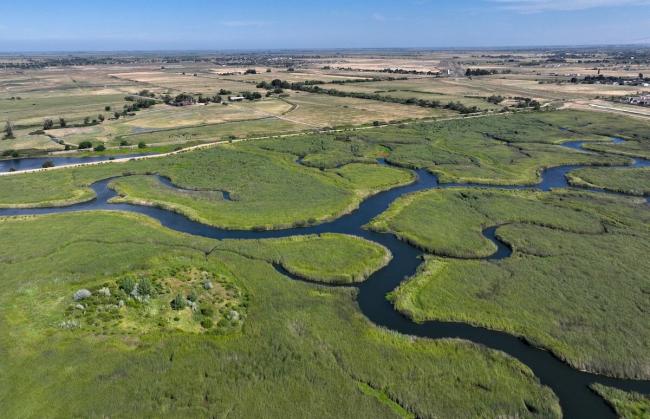Articles Menu

Oct. 14, 2024
Earth’s land-based carbon sinks — forests, wetlands, grasslands and soil — are essential for absorbing atmospheric carbon dioxide, regulating the planet’s temperature and mitigating climate change.
A preliminary report shows that last year — the hottest ever recorded — almost no net carbon was absorbed by land. This means the world’s terrestrial carbon sinks temporarily collapsed, reported The Guardian.
“We’re seeing cracks in the resilience of the Earth’s systems. We’re seeing massive cracks on land – terrestrial ecosystems are losing their carbon store and carbon uptake capacity, but the oceans are also showing signs of instability,” said Johan Rockström, Potsdam Institute for Climate Impact Research director, at a New York Climate Week event last month, as The Guardian reported. “Nature has so far balanced our abuse. This is coming to an end.”
The terrestrial breakdown of carbon absorption last year could be provisional and due to the excessive drought and wildfires caused by global heating putting pressure on carbon sinks.
Humans produced a record 41.2 billion tons of carbon pollution in 2023. Without the planet’s carbon sinks performing their essential ecosystem services at a normal rate, reaching net zero will not be possible.
A fast-paced collapse of terrestrial carbon sinks has not been taken into account in most climate models.
“This stressed planet has been silently helping us and allowing us to shove our debt under the carpet thanks to biodiversity,” Rockström said. “We are lulled into a comfort zone – we cannot really see the crisis.”
The Congo basin is the one major tropical rainforest in the world that is still a strong carbon sink, removing more than is released back into the atmosphere.
Soil is second only to oceans as Earth’s largest active carbon store, but its collective emissions are predicted to increase by up to 40 percent by 2100 if they keep up at their current rate. The climate crisis is causing soils to become drier and microbes to break them down more quickly.
Oceans remain the biggest carbon sink on Earth — absorbing 90 percent of fossil fuel warming in recent decades — which has led to a fast rise in sea surface temperatures. Studies have found indications that this pressure has weakened the ocean as a carbon sink.
Researchers say carbon flow through the ocean and land is still in great part a mystery, as opposed to actual human emissions, which have become increasingly easy to measure.
“Overall, models agreed that both the land sink and the ocean sink are going to decrease in the future as a result of climate change. But there’s a question of how quickly that will happen. The models tend to show this happening rather slowly over the next 100 years or so,” says professor Andrew Watson, head of the marine and atmospheric science group at Exeter University, as reported by The Guardian. “This might happen a lot quicker. Climate scientists [are] worried about climate change not because of the things that are in the models but the knowledge that the models are missing certain things.”
Scientists have said that many Earth systems models include some of global heating’s effects on the planet — such as the slowing of ocean currents and the destruction of the Amazon rainforest — but other more recent events have yet to be incorporated.
“None of these models have factored in losses like extreme factors which have been observed, such as the wildfires in Canada last year that amounted to six months of US fossil emissions. Two years before, we wrote a paper that found that Siberia also lost the same amount of carbon,” said Philippe Ciais, one of the new paper’s authors and a French Laboratory of Climate and Environmental Sciences researcher, as The Guardian reported. “Another process which is absent from the climate models is the basic fact that trees die from drought. This is observed and none of the models have drought-induced mortality in their representation of the land sink. The fact that the models are lacking these factors probably makes them too optimistic.”
The planet’s ability to absorb carbon weakening even moderately would make much steeper reductions in greenhouse gas emissions necessary to get to net zero.
“We shouldn’t rely on natural forests to do the job. We really, really have to tackle the big issue: fossil fuel emissions across all sectors,” said Exeter University professor Pierre Friedlingstein, who oversees the yearly calculations of the Global Carbon Budget, as reported by The Guardian. “We can’t just assume that we have forests and the forest will remove some CO2, because it’s not going to work in the long term.”
Cristen is a writer of fiction and nonfiction. She holds a JD and an Ocean & Coastal Law Certificate from University of Oregon School of Law and an MA in Creative Writing from Birkbeck, University of London. She is the author of the short story collection The Smallest of Entryways, as well as the travel biography, Ernest’s Way: An International Journey Through Hemingway’s Life.
[Top photo: The Dutch Slough Restoration Project in Oakley, California was more than halfway completed on Aug. 1, 2023. The project is designed to create a powerful carbon sink while restoring wetlands to bring back native wildlife. Jane Tyska / Bay Area News Group]